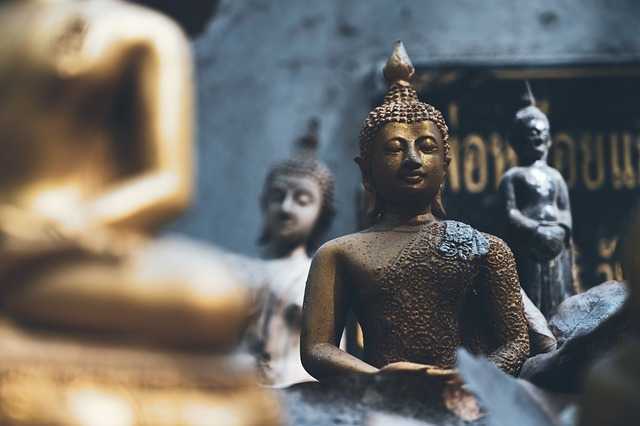Table of Contents
- Exploring the Evolution of Western Art Through the Ages
- Key Movements That Shaped Western Artistic Expression
- Iconic Artists and Their Lasting Impact on Culture
- Collecting Western Art: Tips for New Enthusiasts
- Q&A
- Wrapping Up


Exploring the Evolution of Western Art Through the Ages
The journey of Western art is a captivating narrative marked by myriad transformations, reflecting the cultural, social, and political shifts throughout history. Beginning with the classical antiquity, artists sought to capture the idealized human form, drawing inspiration from ancient Greece and Rome. This period was characterized by a focus on proportion and symmetry, with notable works such as the sculptures of Phidias and the architectural marvels like the Parthenon, which remain benchmarks of beauty and craftsmanship.
As we transitioned into the Middle Ages, the art underwent a significant transformation influenced primarily by religion. The emergence of Christian iconography led to the creation of spiritual and symbolic artworks, emphasizing the divine rather than humanism. Important artistic styles, such as Romanesque and later Gothic, introduced elements like stained glass windows and intricate sculptures that adorned cathedrals. Artists shifted their focus from the anatomical accuracy of the human figure to conveying narratives that aligned closely with the teachings of the Church.
The Renaissance heralded a glorious return to classical ideals, sparking a rekindled interest in humanism and the natural world. Artists like Leonardo da Vinci and Michelangelo pioneered techniques that enhanced realism—using perspective, chiaroscuro, and anatomical studies. This era saw the birth of masterpieces such as the Mona Lisa and the Sistine Chapel ceiling, which exemplified the human experience and portrayed figures with both grace and emotion. The juxtaposition of classical elements with innovative techniques distinguished the Renaissance as a pivotal era in Western art history.
The subsequent emergence of modern art in the late 19th and early 20th centuries brought about radical changes in artistic expression. Movements such as Impressionism, Cubism, and Surrealism challenged traditional methods and explored new ideas about representation, perspective, and abstraction. Artists like Claude Monet and Pablo Picasso broke free from conventions, choosing to express subjective experiences and emotions through vibrant colors and fragmented forms. Each movement built upon the last, creating a diverse tapestry that continues to influence contemporary art today.


Key Movements That Shaped Western Artistic Expression
Throughout history, several key movements have left an indelible mark on Western artistic expression, each contributing unique philosophies and aesthetics that transformed the evolution of art. This evolution often reflects broader societal changes, providing insight into cultural values, political climates, and technological advancements. Understanding these movements helps to unravel the complex tapestry of Western art, revealing how artists have continually redefined boundaries in their quest for self-expression.
Renaissance emerged in the 14th century, signaling a rebirth of classical ideals and humanism. Artists like Leonardo da Vinci and Michelangelo sought to balance emotion with rationality, producing works that fused technical skill with profound thematic depth. The use of perspective and realism became paramount, as seen in masterpieces such as the Mona Lisa and the David. This period emphasized the beauty of human experience and nature, laying essential groundwork for future artistic endeavors.
Moving into the late 19th century, Impressionism challenged traditional approaches by focusing on the fleeting moments of light and color in everyday life. Pioneered by artists such as Claude Monet and Pierre-Auguste Renoir, this movement marked a shift away from meticulous detail to a more spontaneous technique. Artists often painted en plein air, capturing the essence of a scene rather than its precise depiction. The resultant works evoke an emotional response, forefronting personal interpretation over perfect representation.
In the 20th century, the rise of Abstract Expressionism further reshaped the boundaries of Western art. Artists like Jackson Pollock and Mark Rothko moved toward non-representational forms, emphasizing the act of painting as an emotional outlet. This movement championed individuality, with each artwork embodying the artist’s inner experiences and feelings. By breaking free from traditional aesthetics, Abstract Expressionism laid the foundation for various contemporary practices, prompting ongoing debates about the meaning and purpose of art itself.


Iconic Artists and Their Lasting Impact on Culture
Throughout history, several artists have profoundly shaped the cultural landscape, transforming not only the art world but society as a whole. Leonardo da Vinci, for instance, redefined the techniques of realism and perspective in painting, leaving an indelible mark with masterpieces like the Mona Lisa and The Last Supper. Da Vinci’s meticulous studies of human anatomy and natural phenomena greatly influenced both art and science, fostering a blend of disciplines that continues to inspire innovation today.
In the realm of modern art, Pablo Picasso revolutionized visual representation through the development of Cubism, challenging traditional views of form and perspective. His works, such as Guernica and Les Demoiselles d’Avignon, created significant discourse around the consequences of war and the nature of reality. Picasso’s ability to convey complex emotions and perspectives has left a legacy that resonates with contemporary artists and movements, encouraging them to push boundaries and explore new artistic expressions.
Another pivotal figure is Frida Kahlo, whose deeply personal and vibrant art serves as a commentary on identity, postcolonialism, gender, and race. Kahlo’s unique combination of surrealism and Mexican folk art invites viewers into her intimate world, where personal pain and cultural identity intertwine. Her impact extends beyond art, influencing feminism and empowering women to embrace their own narratives and stories. Exhibitions of her work continue to draw global attention, illustrating her lasting relevance.
Lastly, Andy Warhol challenged the conventions of art with his embrace of popular culture and mass production. Pioneering the Pop Art movement, he blurred the lines between high art and commercialism through iconic pieces like the Campbell’s Soup Cans and Marilyn Diptych. Warhol’s innovative use of repetition and his exploration of celebrity culture provided a fresh perspective on consumerism and society’s values, making his contributions instrumental in understanding contemporary art’s role in reflecting and influencing culture.
Collecting Western Art: Tips for New Enthusiasts
Embarking on a journey into the realm of Western art can be both exhilarating and slightly overwhelming for newcomers. To navigate this unique landscape, it’s beneficial to begin by familiarizing yourself with the styles and movements within Western art. Focus on key periods such as the American West’s depiction in classic paintings, the influence of Native American artistry, and the evolution of contemporary Western art. Each era offers distinct characteristics and themes that reflect the culture and history of the period.
Investing time in local galleries and art fairs can be immensely rewarding when you’re ready to expand your collection. These venues not only showcase works from established artists but also provide a platform for emerging talent. Here are a few tips to maximize your experience:
- Engage with Gallery Owners: Don’t hesitate to ask questions about artists and their work. Their insights can offer valuable context.
- Attend Art Openings: These events are great opportunities to meet artists and fellow enthusiasts, enhancing your understanding of the art community.
- Stay Informed: Subscribe to art magazines or online platforms that focus on Western art trends and news.
Understanding the value of art is crucial in this collecting journey. Be aware that a piece’s worth can be influenced by various factors, including the artist’s reputation, rarity, and provenance. Here’s a brief table illustrating these aspects:
| Factor | Description |
|---|---|
| Artist Reputation | Well-known artists often command higher prices. |
| Rarity | Limited editions or unique pieces are typically more valuable. |
| Provenance | A documented history increases a piece’s worth. |
Lastly, don’t shy away from developing your own personal taste. Collecting isn’t just about investment; it’s about finding pieces that resonate with you on a deeper level. Consider starting a small collection with works that evoke strong emotions or memories. Visit online platforms, estate sales, and auctions to discover diverse options that reflect your aesthetic. Trust your instincts, and above all, enjoy the process of building your collection one piece at a time.
Q&A
Q&A: Exploring Western Art
Q1: What is Western art? A1: Western art refers to the artistic traditions that originated in Europe and later expanded to include the Americas and other regions. Spanning several centuries and styles, it encompasses a diverse range of movements—from the Renaissance and Baroque to Impressionism and Modernism. Western art is characterized by its focus on humanism, perspective, and realistic representation, evolving alongside cultural and historical changes.Q2: How did the Renaissance influence Western art? A2: The Renaissance, flourishing from the 14th to the 17th century, marked a pivotal shift in Western art. It revived classical ideas and emphasized human emotion and realism. Artists like Leonardo da Vinci and Michelangelo pioneered techniques in perspective and anatomy, moving away from the spiritual confines of medieval art. This era laid the groundwork for future artistic movements by celebrating individual achievement and striving for greater realism.
Q3: What are the major art movements in Western art history? A3: Western art has seen a multitude of movements, each contributing uniquely to its evolution. Some of the most significant include:
- Baroque (1600-1750): Known for dramatic use of color, light, and shadow.
- Rococo (1700-1780): Characterized by ornate decoration and playful themes.
- Neoclassicism (1750-1820): A return to classical ideals, emphasizing virtue and simplicity.
- Romanticism (1800-1850): Focused on emotion and the sublime aspects of nature.
- Impressionism (1860-1900): Revolutionized painting with an emphasis on light and movement.
- Modernism (20th century): Challenged traditional norms, leading to abstract and conceptual art forms.
Q4: How does Western art reflect societal changes? A4: Western art serves as a mirror to societal changes, often reflecting political, cultural, and technological shifts. For instance, the emergence of urban landscapes in the 19th century captured the impact of industrialization. Similarly, contemporary art often addresses social issues such as identity, race, and gender, engaging viewers in pressing conversations. By analyzing art from different eras, one can gain insight into the collective attitudes and values of those times.
Q5: Who are some influential Western artists worth noting? A5: Numerous artists have shaped the landscape of Western art. Some notable figures include:
- Vincent van Gogh: Known for his emotional intensity and vibrant use of color.
- Claude Monet: A leading figure in Impressionism, celebrated for his depictions of light.
- Pablo Picasso: A pioneer of Cubism, radically transforming how we perceive form.
- Georgia O’Keeffe: Renowned for her large-scale floral paintings and contributions to American modernism.
Q6: What role do museums play in the appreciation of Western art? A6: Museums are crucial in preserving, showcasing, and educating the public about Western art. They provide access to original works, allowing viewers to engage with art in a profound way. Additionally, museums often host exhibitions and educational programs, fostering appreciation and understanding of art’s historical context and significance. By doing so, they help bridge the gap between the artist and the audience, making art more accessible to all.
Q7: How can I get started in appreciating Western art? A7: To begin your journey in appreciating Western art, start by visiting local galleries and museums, where you can view artworks firsthand. Reading books or taking online courses on art history can also provide valuable context. Engaging with art blogs or joining community discussions can further enhance your understanding. consider keeping an art journal to reflect on your thoughts and feelings about the works you encounter—it’s a great way to deepen your appreciation!
